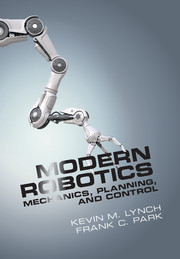Book contents
- Frontmatter
- Contents
- Foreword by Roger Brockett
- Foreword by Matthew Mason
- Preface
- 1 Preview
- 2 Configuration Space
- 3 Rigid-Body Motions
- 4 Forward Kinematics
- 5 Velocity Kinematics and Statics
- 6 Inverse Kinematics
- 7 Kinematics of Closed Chains
- 8 Dynamics of Open Chains
- 9 Trajectory Generation
- 10 Motion Planning
- 11 Robot Control
- 12 Grasping and Manipulation
- 13 Wheeled Mobile Robots
- A Summary of Useful Formulas
- B Other Representations of Rotations
- C Denavit–Hartenberg Parameters
- D Optimization and Lagrange Multipliers
- Bibliography
- Index
8 - Dynamics of Open Chains
Published online by Cambridge University Press: 04 June 2024
- Frontmatter
- Contents
- Foreword by Roger Brockett
- Foreword by Matthew Mason
- Preface
- 1 Preview
- 2 Configuration Space
- 3 Rigid-Body Motions
- 4 Forward Kinematics
- 5 Velocity Kinematics and Statics
- 6 Inverse Kinematics
- 7 Kinematics of Closed Chains
- 8 Dynamics of Open Chains
- 9 Trajectory Generation
- 10 Motion Planning
- 11 Robot Control
- 12 Grasping and Manipulation
- 13 Wheeled Mobile Robots
- A Summary of Useful Formulas
- B Other Representations of Rotations
- C Denavit–Hartenberg Parameters
- D Optimization and Lagrange Multipliers
- Bibliography
- Index
Summary
In this chapter we study once again the motions of open-chain robots, but this time taking into account the forces and torques that cause them; this is the subject of robot dynamics. The associated dynamic equations – also referred to as the equations of motion – are a set of second-order differential equations of the form
where θ ϵ Rn is the vector of joint variables, τ ϵ Rn is the vector of joint forces and torques, M(θ) ϵ Rn×n is a symmetric positive-definite mass matrix, and h(θ, θ˙) ϵ Rn are forces that lump together centripetal, Coriolis, gravity, and friction terms that depend on θ and θ˙. One should not be deceived by the apparent simplicity of these equations; even for “simple” open chains, e.g., those with joint axes that are either orthogonal or parallel to each other, M(θ) and h(θ, θ˙) can be extraordinarily complex.
Just as a distinction was made between a robot's forward and inverse kinematics, it is also customary to distinguish between a robot's forward and inverse dynamics. The forward problem is the problem of determining the robot's acceleration θ¨ given the state (θ, θ˙) and the joint forces and torques, and the inverse problem is finding the joint forces and torques τ corresponding to the robot's state and a desired acceleration, i.e., Equation (8.1).
A robot's dynamic equations are typically derived in one of two ways: by a direct application of Newton's and Euler's dynamic equations for a rigid body (often called the Newton–Euler formulation) or by the Lagrangian dynamics formulation derived from the kinetic and potential energy of the robot. The Lagrangian formalism is conceptually elegant and quite effective for robots with simple structures, e.g., with three or fewer degrees of freedom. The calculations can quickly become cumbersome for robots with more degrees of freedom, however. For general open chains, the Newton–Euler formulation leads to efficient recursive algorithms for both the inverse and forward dynamics that can also be assembled into closed-form analytic expressions for, e.g., the mass matrix M(θ) and the other terms in the dynamics equation (8.1). The Newton–Euler formulation also takes advantage of tools we have already developed in this book.
- Type
- Chapter
- Information
- Modern RoboticsMechanics, Planning, and Control, pp. 231 - 281Publisher: Cambridge University PressPrint publication year: 2017

